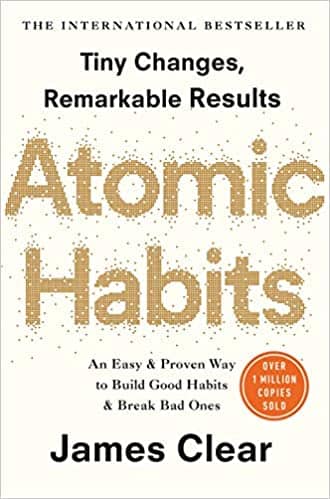This post contains affiliate links, which means that, at no extra cost to you, I may get paid commission if you click through those links and make a purchase. For more information please read my disclaimer.
Have you ever wanted to achieve a goal but run out of steam and ended up abandoning it? This probably has less to do with your motivation and more to do with how you approached the problem. From hitting the gym to reading more or even cutting down on activities such as watching excess TV, focussing not on your goals but on the habits that feed them will determine your success. But how do you build habits that stick? Let’s explore.
What are habits and how do they work?
In his book Atomic Habits, James Clear explains that when setting goals we overestimate the importance of earth-shattering improvements and underestimate the importance of the small changes we can integrate into our daily lives – ones that will compound and lead to real results if we stick with them. These are our habits.
Habits are a series of automatic solutions to the problems and stresses we face in daily life. They require fewer cognitive resources than uncharted actions and are built as follows:
Cue: You receive some information that makes you think about the reward (you see some cake in a shop window).
Craving: Your desire to change your internal state drives your motivation (you begin to crave the cake).
Response: An action is performed. Your response depends on your motivation, ability, and the friction associated with doing the activity (you buy the cake and eat it).
Reward: you receive a reward for taking the action (you satisfy your craving for cake and associate buying it with walking past the cake shop).

(Or put in the words of the great Arianna Grande – I see it, I like it, I want it, I got it… sort of).
There’s a lot more about why we seek rewards and how these habits work that I won’t get into here but make to check out Atomic Habits if you’re interested.
How to start a habit
The name of the game is specificity. Saying ‘I’ll eat more healthily’ or ‘I’m going to wake up earlier’ just won’t cut it. In these situations what you lack isn’t motivation but clarity. Clear this up by filling out the following sentence:
I will [behaviour] at [time] in [location].
There you go. You’ve created your first habit. Exactly what you need to do and when you need to do it. But that’s just the start. Below are some key strategies on how to strengthen positive habits and break bad ones.
Environment
Shaping your environment can greatly influence your habits. Reduce the friction between the habits you want to build and create frictions between the habits you want to break.
- Want to eat more healthily? Make the fruit bowl easily accessible and cut down your stock of sugary items.
- Want to read more? Have a book at your bedside or where you unwind, not tucked away in some bookshelf.
- Want to watch less tv? Unplug the tv and hide the remote. Don’t have Netflix front and centre on your phone’s home page.
Adding simple hurdles to negative activities will make your relationship with them intentional instead of habitual, and vice versa.
Habit stacking
The idea of ‘Habit Stacking’ is simple; to build a new habit, tag it onto a current habit and then combine it with a reward.
- After [current habit] I will [habit I need].
- After [habit I need] I will [habit I want].
Some examples:
- Want to ensure your sink is free of dishes but always leave it too late?
- Finish dinner [current habit] then immediately wash your dishes [habit you need] only then can you have dessert [habit you want].
- Need to make more sales calls but just feel like reading the news?
- When you sit down at your desk [current habit], make three sales calls [habit you need], only then can you read the news for 5 minutes [habit you want].
The idea is simple enough, it just requires some planning around which habits to stack together. Also, the reward is important as it creates an incentive to see your habit through.
Identity
One really powerful technique is linking your habits with your pride by changing how you view yourself. If you’re trying to get more organised you have to believe that you’re an organised person. This will make it harder to break the habit as it’ll conflict with your sense of self.
- Decide the type of person you want to be.
- Convince yourself with small wins.
I use this tactic for this very website. I tell myself that I’m a writer (I’ll let you be the judge of that), and prove it to myself by writing posts every week. It spurs me on to sit down and finish a post, because, well, that’s who I’ve told myself I am.
Conversely, if you think you’re bad at something you won’t be motivated to improve and will maintain a defeatist attitude.
Believe you are who you want to be and you’ll become it. Capiche?
Reframing
Simply changing your mindset to highlighting the benefits over the drawbacks of a certain task can make it more bearable. For example, going from ‘I have to cold call’ to ‘I get to cold call’ may be enough to shift your perspective on the endeavour.
A weird trick I’ve started using whenever I feel anything but positive is reminding myself that it’s a privilege to get to experience this emotion. It might sound insane but it oddly works for me. Annoyed about something? At least I’m alive and well enough to feel what it’s like to be annoyed. Every emotion is an experience.
However, I must caveat that it’s only a palliative measure for making a momentary mental pivot. For longer-term or recurring miseries there might be real-world changes to your environment or yourself that need to be addressed.
Start with just 2 minutes
When starting a new habit it’s easy to feel overwhelmed by how far you have to go to achieve your goal, chancing that you quit before you ever get going. To combat this, James Clear suggests making a ‘gateway habit’ which is your goal broken down into its most basic task. It’s one that you can commit to doing in just two minutes.
- Want to run a marathon? Start by just putting on your shoes and stepping outside.
- Want to read a whole book? Start by reading just one page.
You can walk away if you want after completing the action. Just make sure to do it every single day and eventually you’ll find yourself doing more (you’ve already read a page, why not another?). Initially, it’s all about getting used to showing up. Of building a ritual.
Be patient
The frustrating thing with habits is that you don’t see results quickly. Everyone wants an overnight miracle but the reality is that great things take time.
This idea is big, especially in fitness. People that go to the gym every day are probably past the point of needing to psych themselves up. It’s just part of their routine. It’s a habit and it allows them to stay fit. Just like that, once you stop thinking of the habit as a chore or extra activity to make time for in your day and simply let it be part of who you are, you’ll show up and eventually reap the benefits.
That’s it! These are some key ideas I’ve started using to build my habits and work towards my goals. While it’s easy to read something then move on with your life, promising you’ll use that information at some point, I’d urge you to sit down and think about any goals you have and how you can use the above to achieve them. Plan it, practice it, and see the results.

Also, I would highly recommend getting a copy of James Clear’s Atomic Habits as it shares loads more ideas and goes into great detail. It might be one of the best books I’ve read this year and think it can bring real value to anyone looking to build their habits.
Good luck!
We are what we repeatedly do. Excellence, then, is not an act, but a habit.
Aristotle
Ps. Make sure to join the mailing list for updates and cool extras. This week I shared a resource that makes building habits fun by gamifying your goals.


